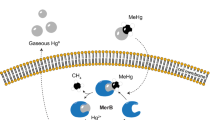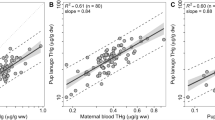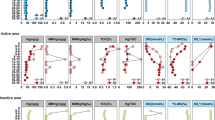Abstract
IT has been established that selenium exerts a protective effect against the toxicity of methylmercury1–5. A study on higher marine mammals suggested that the antagonism between selenium and mercury may result in a marked accumulation of both elements in the organs of the animals6, and a similar observation has been made in the laboratory7. In retrospect, this beneficial mechanism was operative, though incompletely, during the period when a wide area around the city of Minamata was polluted with methylmercury discharged from a factory involved in the production of acetaldehyde : the organs of men and cats who died from Minamata disease showed elevated levels of selenium as well as mercury8,9. Furthermore, the highest concentration of these substances was noted in the liver of an apparently healthy cat (Hg, 301 p.p.m.; Se, 89.7 p.p.m.) caught in a village 10 miles north of Minamata8,9. We report here that the umbilical cords of the inhabitants of Minamata seem to reflect a chronological transition in methylmercury pollution but no corresponding shift in selenium levels.
This is a preview of subscription content, access via your institution
Access options
Subscribe to this journal
Receive 51 print issues and online access
$199.00 per year
only $3.90 per issue
Buy this article
- Purchase on SpringerLink
- Instant access to full article PDF
Prices may be subject to local taxes which are calculated during checkout
Similar content being viewed by others
References
Ganther, H. E., et al., Science, 175, 1122–1124 (1972).
Ganther, H. E., and Sunde, M. L., J. Fd Sci., 39, 1–5 (1974).
Iwata, H., Okamoto, H., and Ohsawa, Y., Res. Comm. chem. path. Pharmac., 5, 673–680 (1973).
Stoewsand, G. S., Bache, C. A., and Lisk, D. J., Bull. environ. Contam. Toxicol., 11, 152–156 (1974).
Potter, S., and Matrone, G., J. Nutr., 104, 638–647 (1974).
Koeman, J. H., et al., Nature, 245, 385–386 (1973).
Ohi, G., et al., Toxicol. appl. Pharmac., 32, 527–533 (1975).
Ueda, K., J. Kumamoto Med. Soc., 34, Suppl. 1, 141–155 (1960).
Uzioka, T., ibid., 34, Suppl. 2, 383–399 (1960).
Westöö, G., Acta chem. scand., 22, 2277–2280 (1968).
Watkinson, J. H., Analyt. Chem., 38, 92–97 (1966).
Fujiki, M., Takima, S., and Ohmori, A., Jap. J. Hyg., 27, 115 (1971).
Harada, M., Kagaku, 41, 250–258 (1971) (in Japanese).
Kosta, L., Byrne, A. R., Zelenko, V., Nature, 254, 238–239 (1975).
Harada, M., Adv. neurol. Sci., 16, 870–879 (1972) (in Japanese).
Author information
Authors and Affiliations
Rights and permissions
About this article
Cite this article
NISHIGAKI, S., HARADA, M. Methylmercury and selenium in umbilical cords of inhabitants of the Minamata area. Nature 258, 324–325 (1975). https://doi.org/10.1038/258324a0
Received:
Accepted:
Issue date:
DOI: https://doi.org/10.1038/258324a0
This article is cited by
-
Secondary sex ratio in regions severely exposed to methylmercury “Minamata disease”
International Archives of Occupational and Environmental Health (2016)
-
Mercury pollution: an emerging problem and potential bacterial remediation strategies
World Journal of Microbiology and Biotechnology (2009)
-
Factors in Fish Modifying Methylmercury Toxicity and Metabolism
Biological Trace Element Research (2007)
-
Age standardized cancer mortality ratios in areas heavily exposed to methyl mercury
International Archives of Occupational and Environmental Health (2007)
-
Minamata disease: A 1989 update on the mercury poisoning epidemic in Japan
Environmental Geochemistry and Health (1991)



